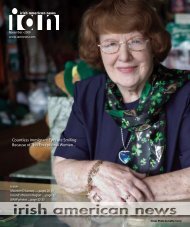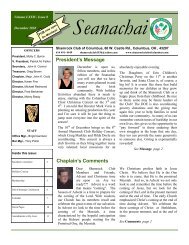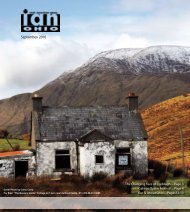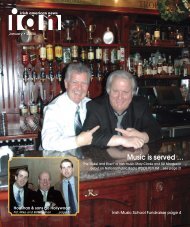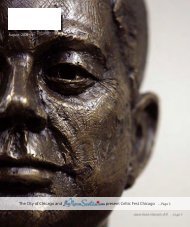Catie Keogh - Irish American News
Catie Keogh - Irish American News
Catie Keogh - Irish American News
- No tags were found...
Create successful ePaper yourself
Turn your PDF publications into a flip-book with our unique Google optimized e-Paper software.
August 2011 <strong>Irish</strong> <strong>American</strong> <strong>News</strong> “We’ve AlWAys Been Green!” 31Somebody Out There Likes UsDespite our economic woessomebody out there likes usand wants to come here to live!The very first results of the 2011census have appeared—the headcount. They show that the populationof the republic has risen to4,581,269, an increase of 340,000,or 8.1%, since 2006. The size ofthe increase came as a surprise toofficialdom, exceeding estimatesby 100,000. It would appear that,in addition to a high birth rate,more people arrived and stayedand fewer left than had beenthought. Given that even nowliving standards here (and thesocial welfare system) comparefavourably with those in CentralEurope and the Baltics, let alonethe third world, should anyonehave been surprised?The 2011 figures suggest at thevery least that one of the commonofficial assumptions concerninginward migration needsrevisiting, i.e., that many of thosewho came “for work” during theTiger Years would leave when theeconomy imploded. Certainlysome have, and the number arrivinghas diminished, yet manymore have stayed. The actualfigures will not become clearuntil more detailed data fromthe census becomes availablenext year, but recent contactsand exchanges I have had withjust three embassies in Dublinpaint a very interesting picture.The myth of the mobile transientPolish building worker needs tobe put to rest.There are now probably200,000 Poles living in Ireland,anywhere up to 100,000Lithuanians and 30,000 Latvians.These three nationalitiesalone now comprise 7% of thecountry’s population. Anyonewho has been an emigrant, oris familiar with the pattern of<strong>Irish</strong> emigration over the yearswill not be surprised, given thenumbers who came to Irelandfrom 2004 on. Once the emigrationpain barrier of several yearshas been reached, experiencesuggests that a good proportionof immigrants will stay, put downroots, develop relationships andstart families. These people arenot going anywhere.Similar considerations applyto the 75,000 immigrants fromthree other Central EuropeanEU states—the Czech Republic,Slovakia and Hungary, who arrivedhere during the boom (toend 2008). It’s fair to assumethat they have stayed on in muchthe same proportion as the others,i.e., anywhere up to 50,000.Moreover, though the numbersarriving from these six EU stateshave declined sharply since2008, PPS registrations for thesix (our equivalent of social securitynumbers) in 2009 totalled26,000, in 2010, 18,500 and, inthe first five months of 2011,6,000. Poles continue to registerat over 100 per week. Again, it isreasonable to assume that mostof these latecomers, who camewith their eyes open, post-boom,are still here.These EU migrants had oneother thing in common—norestriction on the right to workin Ireland. People from non-EUcountries, and Romania andBulgaria after 2007, require workpermits, and, in terms of receivingwelfare benefits, must meetthe criteria for “habitual residence”regulations introduced byIreland and others of the “richer”EU states after 2004 to combatwelfare shopping by immigrants(and, incidentally, applied toincoming <strong>Irish</strong> citizens andreturned emigrants). The totalnumber of new work permits issuedto all nationalities in 2008was 8,481, declining to 4,024 in2009 and 3,394 in 2010. Romaniansreceived just under 1,100of these.Nevertheless, 22,000 Romaniansreceived PPS numbers in2007 and 2008 and a further5,500 in 2009 and 2010; around1,500 have done so this year.The figures for Brazilians (whoreceived slightly over 500 newwork permits since 2008) areeven more startling. This is anon-EU state with which Irelandhas few historical or trading links(unlike Argentina, where thereis a large population of <strong>Irish</strong>descent). Between 2006 and2008 almost 14,000 Braziliansreceived PPS numbers, in 20092,741, while the figure for 2010was 4,257 (as compared to 143Argentinians). To date in 2011,2,553 PPS numbers have beenissued to Brazilians, almost asmany as to Poles. Again, presumablymost of the latest arrivals,plus a good proportion of thosewho have arrived since 2007have stayed. Ditto with regard tothose coming from third worldcountries, roughly 8,000 in 2010.The message is clear. Despite ourcurrent economic difficulties,Ireland continues to be attractiveto those coming from poorersocieties.To complete the picture, thereis more affluent immigrationalso and, all told, in 2010, around70,000 PPS numbers were issuedto non-<strong>Irish</strong> people (the 85,130issued to <strong>Irish</strong> people were, witha few exceptions, to babies), arate being maintained this year,despite the economic situation.While emigration has picked upthe net inflow continues and, asthe census has revealed, its extenthas been underestimated.The consequences of continuedstrong inward migration havereceived little public attention.While there was considerablecoverage and hand-wringingover estimates of up to 50,000young <strong>Irish</strong> people emigratinglast year, there has been little orno focus on the fact that 35,000plus arrived here last year aseconomic migrants. Clearlyshould this trend continue, ontop of the current situation, it willadd considerably to the problemof tackling unemployment, stillstubbornly high at 450,000.The recovery of the 90s tookplace initially with no inwardmigration, a static or decliningpopulation and a work force inwhich women were underrepresented.This has now changed utterly,and, while there are almostdaily announcements of new jobsin the multinational sector, theyare not impacting on the total outof work. Like Spain, Ireland maybe entering a period with chronichigh levels of unemploymentcompounded by immigration and,in Ireland’s case, a demographicstructure which promises a continuedhigh birth rate.The detailed breakdown of thepopulation by age, nationality orethnic origin etc. will becomeclear as more of the census resultsbecome available, but, generally,more people means morepressure on resources. At a timeof financial stringency this willcause the state some headaches,but there is one potential silverlining. More people also meansmore demand, including for accommodation,so an economicrecovery should see a surge indemand for housing, helpingto solve the overhang of excesshousing units and correct thecurrent imbalance.Having a sizeable percentageof the population non-<strong>Irish</strong> raisesother issues, which were pointedto in the 2006 Census, but whichare likely to become more pressing.Not least of these relates todemocratic representation. Onlycitizens can vote, but any reviewof the Constitution (which is beingmooted) can hardly ignore theissue of the vote for non-nationals.The issue of multiculturalismalso needs addressing in a morecoherent way than up to now. Thedata from the Census will be criticalin this regard.Some historical perspective.The current population figure ofalmost 4.6 million is still far shortof the 1841 total of 6.5 millionfor the 26 county area, and, whilethe population of Leinster is nowone third higher, the populationof Munster is a little over half thepre-Famine level, while those ofConnacht and Ulster are 60% less.It will take a lot more inward migrationto dent that shortfall.For Booking: www.celticratpack.com







